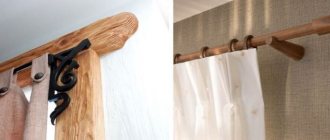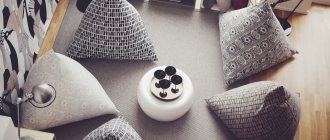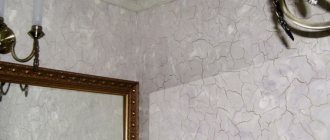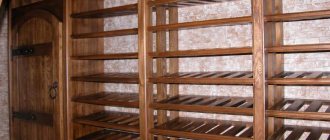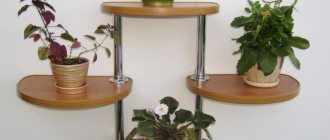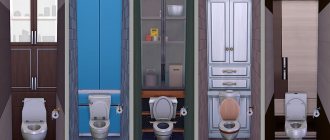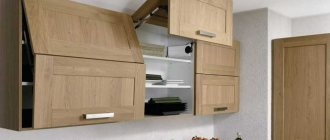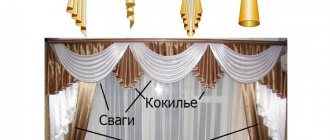Parents set a goal to comprehensively develop their baby, starting from birth. A crawling mat can help with this. You can purchase the device at a children's store. But it’s much more interesting to make it yourself.
Loving parents, trying to develop their child from birth, use modern techniques and all kinds of expensive toys.
What is a developmental mat
A rug is a canvas made of yarn or thick fabric. May have different forms. The main idea when creating an educational rug with your own hands is to make it bright and colorful to interest the baby. It should consist of different textures with colorful applications, complemented by buttons, rattles, and musical details.
Thanks to the moving elements, the child will develop fine motor skills.
Mats functions:
- Development of fantasy and imagination.
- Training concentration, memory and fine motor skills.
- Development of logical thinking.
- Basic study of the alphabet, numbers, objects, geometric shapes.
- Recognition of colors and shades.
You can buy such a rug in a store, but many women prefer to make it with their own hands, because it is not at all difficult to do.
Leading global manufacturers
There are enough manufacturers of educational mats, since this topic is in demand among parents in every corner of the world. Let's name companies that have been recognized for quality, interesting solutions and usefulness of products.
Balio is a Chinese brand, whose representative in the Russian Federation has become. The catalog contains models of comfortable small rugs equipped with arches. Age marking: from three months. The set includes a safe mirror, hangers in the form of toys and rattles.
Bright Starts is ready to follow all trends of innovation and offer 13 models of mats for children's development: these are products of different shapes and configurations.
Fisher Price is an American brand that produces some of its products for children in the form of various play mats.
Other worthy competing companies are Infantino , Lider Kids , Smoby , Taf Toys , Nattou , Tiny Love .
Basic requirements for educational mats
When making a children's rug with your own hands, it is important to adhere to certain requirements.
An educational mat is a textile or knitted cloth, decorated with bright appliqués, with movable elements for play placed on it.
- The quality of materials and components used during assembly must be of the highest quality. They should not cause allergies in the child.
- All seams and connecting elements must be tightly stitched and fastened together. This is especially true for small accessories that a child can place in his mouth or nose.
- The touch mat must contain only serviceable components.
Do not allow chips, cracks, or unraveling seams.
- When making canvas, it is necessary to take into account versatility. After a few months, the child's interests will change. It will be necessary to replace some parts or supplement existing ones. You can make your own children's crawling mat, equipping it with folding sides, allowing you to expand the playing area over time.
- The toy must be mobile and compact so that, if desired, it can be easily transported and folded.
This rug gives children the opportunity to develop from the first days of life, and is designed for use up to 3 years of age.
- When choosing or creating a sensory mat for children, it is important to take into account age characteristics. It is not recommended to equip a carpet for a baby with many toys and musical elements, since at this age the baby does not yet perceive complex structures and mechanisms.
- All plastic parts should be easy to unfasten for easy washing.
- When making an educational rug for children with your own hands, it is advisable to use different colors and textures, and many interactive, noisy elements.
They will help attract the child's attention and interest him.
Materials for production
To make a rug for the nursery with your own hands, you will need the following materials.
Materials and tools for the rug.
- It is best to use foam rubber or padding polyester as a base.
- Considering that the child will spend a lot of time on the rug, finishing materials should be natural. They do not cause allergic reactions or irritation. Note! The fabric should not accumulate static electricity.
- The color palette of the toy should be varied. However, it should be borne in mind that too bright, contrasting combinations will have a negative impact on the child’s psyche, tiring and boring him.
- For decoration, you can use large buttons of different colors, elastic bands, thick threads and ribbons, ropes and Velcro.
- To make a play mat with your own hands, you will need to purchase high-quality plastic and mechanical parts.
For a child, a developmental mat will become the largest and most useful toy that will never get boring.
The best models according to customers
The Belgian company Nattou has many models of educational mats for children up to one year old. They are aimed at developing the grasping reflex, perception of colors and sounds. This company has interesting rugs for kids.
Model “Giraffe” and “Elephant” from Nattou PHOTO: nattou.ru
The Giraffe and Elephant models are great. They meet all the requirements for child development and safety. The products are suitable for use from birth as they are warm and cozy. Bright colors do not irritate the eyes, the rugs look nice and fit any nursery design.
The models are based on 100% hypoallergenic polyester. The set includes musical toys that are attached to the arches with plastic locks.
This model costs 4260 rubles.
It is worth considering the option of purchasing an educational jungle mat from WinFun .
The jungle is calling PHOTO: dochkisinochki.ru
This is a themed rug dedicated to the vibrant world of the jungle, which both boys and girls enjoy from birth. The set includes arches and five pendants with rattles and a rustling sound. The materials used are textiles and PVC.
Design ideas
Before you start work, you need to decide on the shape and decorative elements. For convenience, it is advisable to draw a sketch of the canvas on paper. Having looked in advance at ideas for designing educational rugs for children from 0 to 3 years old with your own hands, it will be much easier to come up with an interesting and entertaining design. For very young children, sensory, didactic canvases, or those made from soft pom-poms are suitable.
For older children, an excellent option would be those where you can develop not only fine motor skills, but also logic - puzzle mats, puzzles, mosaics.
Separately, it is worth highlighting rugs for girls - most often they are round or oval, with several zones that reflect the interests of the daughter. It can be supplemented with flaps and pockets. Shades of pink predominate. For boys, the car theme is most often used. The older the child, the more detailed the drawing should be. Popular colors are blue, cyan, green. It is recommended for active fidgety children to build a rug with soft sides. You can use not only filler as a barrier, but also an additional layer of pompoms.
When the child grows up and begins to sit independently, he will be able to play with it and develop without outside help.
To make educational rugs for children with your own hands, you will need fabric patterns. With their help, various figures are sewn for decoration and applique. These can be animals, trees, plants, windows, cars, clouds, fairy-tale and cartoon characters.
Bright applications and a large number of various elements will occupy the child’s attention for a long time.
We create an educational mat for children with our own hands
The process of creating a children's educational rug with your own hands is not difficult. And most importantly, the product will be individual, taking into account all the needs of the baby.
When playing with such a toy, the child will feel your warmth, love and care.
You should start work by developing a sketch. You can draw a diagram on whatman paper. Next, you need to follow the instructions, which describe in detail how to make educational rugs for a child with your own hands.
Preparation of accessories
The first step is to purchase all the necessary accessories - buttons, ribbons, fasteners, beads, Velcro, threads, fasteners. The tools you will need are scissors, a needle, a stationery knife, and bobby pins. At the same stage, it is advisable to draw diagrams of future applications and cut them out.
Below we will describe everything in detail on the topic of how to sew a developmental mat with your own hands.
Preparing the base
This stage involves creating a diagram of the finished canvas. You also need to select materials. It is recommended to give preference to natural, non-slip compounds with antistatic properties. These include calico, flannel, felt, cotton. If you intend to create knitted elements, you must choose cotton yarn.
Soft materials cause pleasant tactile sensations and do not provoke allergic reactions.
Important! It is necessary to take care of high-quality internal filler. A baby rug is designed for crawling and is most often placed on the floor. It must be well insulated. It is recommended to use padding polyester or foam rubber.
Before you sew the parts of a baby's educational rug with your own hands, you need to decide on the front and back sides. After this, you can start cutting out the upper and lower parts and the filler. Be sure to leave seam margins on all sides. Then you need to overcast the edges, not missing any protruding threads.
Creation of a playing field, production of game elements
At this stage, you will need to sew on all pre-prepared appliqués and drawings. Then you should firmly attach the fittings, mechanical and musical elements, and rattles. Particular attention must be paid to the quality of fastening of small parts, such as buttons and beads. The child should not be able to tear them off. It is recommended not to use glue, replacing it with thick threads.
Adhesive bases are acceptable for fastening fabric elements and appliqués.
Securing elements to the mat
Large fittings can be made either firmly attached to the base or movable. Safe soft parts can be attached using buttons and Velcro.
This will make them easier to remove before cleaning and washing.
After completing the preparatory work, you can proceed to combining all the parts. To do this, you will need to tightly sew all the components together from the wrong side and turn them right side out.
Interesting ideas
The advantage of a homemade rug for children is its uniqueness. When creating it, it is possible to take into account all the characteristics and interests of the baby. Below are several ideas that will help parents decide on the plot of the playing field for children from 0 to 3 years old.
You choose the materials for its manufacture yourself and you will know exactly what it is made of.
- A bee hiding in a bright flower.
- Christmas tree with buttons for fastening toys.
- A castle for cartoon characters, equipped with opening doors and windows.
- Ships, boats, cars, attached using tape in a movable way. This way, the baby will be able to move objects independently.
- Multi-colored trees, clouds, plants.
- For older children, you can choose more complex applications - traffic, scenes from fairy tales.
- It is recommended to equip rugs with pockets in which the child can put his favorite toys.
Interesting models
Thrifty and prudent parents will love the universal developmental mats that grow with the child. Raised sides will allow you to turn the rug into a cozy house for a month-old baby, and when the baby grows up, the sides can be folded out, significantly increasing the play space. A set of play elements can be placed on the carpet depending on the age of the child.
The bag-mat easily turns into a convenient portable bag or toy chest. This model is convenient to take on a visit, for a walk or to a doctor’s appointment. Using a special handle, the mat-bag can be hung on the stroller.
Great idea - a double-sided rug . If the young explorer is bored with one side, there is always the opportunity to turn the rug to the other side and give the baby new experiences. Parties can be designed for different ages. This rug will last longer.
The puzzle mat is intended for older children, from one to 7 years old. It is made of safe and non-toxic polymer. With this rug, a child can assemble a whole picture, the alphabet, or a city street with road signs. Games on such a carpet are very useful; they develop spatial thinking and geometric associations.
Rug with arcs yourself
A good idea for creating a rug for children with your own hands is to equip it with special arcs. You can attach toys, musical mechanisms, and rattles to them.
Thanks to such elements, you can concentrate the child’s attention.
The process of creating a canvas for a children's room consists of the steps listed below. To sew elements of a developmental rug for children from 0 to 3 years old, you need to adhere to the following sequence.
Mat base
To make a sensory mat for children with your own hands, equipped with arcs, you will need several meters of natural fabric and a material that serves as a seal - padding polyester or foam rubber. If you don’t want to create patterns for appliqués from fabric, you can purchase one that is already decorated with children’s patterns.
For the wrong side, a plain calico is suitable.
To create a rug for children with your own hands, size 1 square. m. you will need:
- Main fabric with printed pattern – 2 m;
- Plastic hoop with a diameter of 90 cm;
- Background fabric without patterns - 4 colors, 30 sq. cm.;
- Foam rubber – 1.5 sq. m.;
- Ribbons, Velcro, colored ropes, pompoms;
- Adhesive tape, preferably in different colors;
After choosing fabrics for the base, you need to start cutting:
- The bottom part is cut first. A pre-prepared paper diagram is applied to the selected base and carefully outlined with soap or pencil. Be sure to leave gaps for seams. After marking, you can cut the fabric.
- Next, you should cut out even squares from the background fabric, which are sewn together one by one. You should get a contrasting pattern. It is important to make all seams tightly and efficiently, leaving them from the inside of the product.
- Educational toys are sewn to the top.
- After this, the front side can be sewn to a sealant - foam rubber or padding polyester.
It is better to use fabrics of different tones to create a product - cold and warm shades.
Arcs
The selected hoop is divided into two equal parts using a stationery knife.
- The hoop is divided into parts - 125 cm and 132 cm.
- To give softness to the resulting arches, it is recommended to wrap them tightly with padding polyester, securing it with threads.
- After this, the arcs must be decorated with colored fabric.
Pieces of padding polyester must be attached to each half of the hoop, pressing tightly and wrapping them with threads at intervals of 2–3 cm.
Connecting the arches and the base of the mat
The best option is to thread the arcs through the holes and secure them with wide Velcro on the inside.
To prevent the arcs from jumping out, you need to tightly wrap the pockets with the arcs with material.
- Through slots should be made close to the junctions of the background and the center.
- Then it is recommended to sweep them.
- Velcro is sewn on the bottom part (closer to the outer corners).
- The second halves of the Velcro are attached to the arcs on the front surface.
- The arches are folded crosswise, and a thick braid is attached to the bottom to secure the structure.
- The touch mat is ready.
Types of rugs for the development of babies: a wide choice for our children
Many varieties of developmental models have been invented. In general, they come down to several variations with different configurations.
Simple and with voluminous elements
Simple products are sewn from multi-colored scraps of textured textiles. These are bright items with children's themed applications.
This thing is easy to clean and wash PHOTO: ru.dzvranje.org
Often additional elements include pockets, buttons, loops, and elastic bands.
The version with volumetric elements is distinguished by the presence of removable and non-removable toys. These objects can be manipulated, causing them to rustle, rattle, get tied and untied. Volumetric details develop tactile perception.
With arches and borders-limiters
The arches on the mats are covered with soft textiles. Toys and rattles of various types are attached to them. Children lie on their backs, admire things, reach out to them, touch them, try them out.
There are mats with limiting edges. The models are extremely convenient for maternal peace of mind - the child will not fall out or roll out of it. The sides are lowered, increasing the area of the carpet.
Sides promise safety PHOTO: akusherstvo.ru
Gaming and thematic
Play mats with music and light accompaniment are interesting. Such a thing occupies a child for a long time, giving him “food” for thought. To reproduce the effects, there is a special panel with keys or toys that make sounds.
Baby's first piano PHOTO: detmir.ru
For older children, purchase themed rugs with images of streets with roads, letters of the alphabet and numbers.
Option for older children PHOTO: kids.akb.ua
Double-sided and puzzle mats
If the model is marked 2 in 1, then you are in luck: on one side your baby will play in the early period, and then the product needs to be turned over and used for the side for slightly older children.
It is advisable to buy a puzzle for children over one year old. They are already able to manipulate the elements of the rug, folding a simple picture, letters or numbers.
Puzzle carpet PHOTO: vanechka.by
Developmental activities with a mat
The functions of a homemade sensory mat are very diverse.
All that remains is to hang the toys from the arcs using satin ribbons or cotton braid.
- Infants can be placed on their stomach. In this position, they will be able to look at colorful pictures, trying to reach them with their hands. This develops concentration and tactile sensations.
- After the child learns to sit, you can place the canvas on the floor and join him, showing in a playful way what can be done with different toys.
- Older children can fasten buttons and zippers and move elements on their own. These actions develop fine motor skills of the hands.
- As they grow older, a hand-made educational mat for newborns can be equipped with letters and numbers.
- It is important to pronounce all actions and names of objects during the game. This way the child will train attention and memory.
A hand-sewn carpet for a nursery will delight a child for several years. And it will help parents free up some time by keeping their baby occupied. Made with love, it will bring joy and fun to the baby, leaving only warm memories.
Advantages and Benefits
Starting from the first months of life, there is active growth and development of the baby’s brain activity. The environment influences this process. A children's educational mat will be a useful find for a small child.
Parents will be able to take a break while their child is busy with bright applications or toys. It is necessary to demonstrate to the child what can be done with each item and teach him to use all the game parts.
This educational activity will help:
develop mental abilities;- train logic;
- concentrate attention on objects;
- train memory;
- develop imagination;
- recognize the shapes and colors of things;
- learn the names of animals, fruits, vegetables, numbers and letters;
- improve coordination and motor skills of fingers;
- conduct role-playing games.
The mat will help expand the child’s logical base, teach him to think and achieve his goal.
